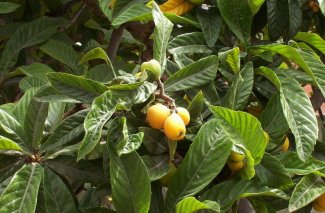Native to temperate Asia: China: China - Hubei, - Sichuan
Eastern Asia: Japan - Honshu, - Kyushu, - Shikoku
It is a large evergreen shrub or small tree, grown commercially for its yellow fruit, and also cultivated as an ornamental plant.Eriobotrya japonica was formerly thought to be closely related to the genus Mespilus, and is still sometimes known as the Japanese medlar. It is also known as Japanese plum and Chinese plum. Noted as a non-native tree in California.
The loquat (Eriobotrya japonica) is a species of flowering plant in the family Rosaceae, native to south-central China. It is a large evergreen shrub or small tree, grown commercially for its yellow fruit, and also cultivated as an ornamental plant. The loquat tree, Eriobotrya japonica, is an evergreen broadleaf tree or shrub originally native to south-central China, being most famous for its sweet, succulent fruit. Through the years it has been established in subtropical to southern temperate regions across the world and has naturalized in many places. It’s species epithet, japonica, is in truth a misnomer since it was first encountered by a westerner, the botanist Thunberg, in that country. Regardless, the plant has gained notoriety across the globe as an ornamental tree, for its fruit products, as tea (loquat leaf tea) and to a lesser extent, as a medicinal herb. E. japonica probably was first cultivated for its fruit. Like many other fruit trees, typical wild forms do not usually produce desirable fruit, so selective breeding was needed. Loquat trees are thought to have been cultivated in China for over a thousand years. This tree (known as biwa in Japanese) made its appearance as a cultivated plant during the late Edo Period in Japan (1603-1868), though wild forms with undesirable fruit likely had been brought centuries earlier. Loquats were first cultivated in Europe as early as the 1700′s. It is believed that Chinese immigrants brought the tree to the Hawaiian Islands in the late 1700′s. Through the years many cultivars (some sources say nearly a thousand) have been developed the world over. Some are white fleshed, smooth skinned, extra large size (c.v. ‘Big Jim’), strawberry flavored (c.v. ‘Strawberry’), late ripening (c.v. ‘Tanaka’), and ones with simply superior taste. One important note – varieties cannot be expected to be true from seed, therefore they must be grown as grafted plants, so buyer beware! In the world Japan is the primary grower of loquat fruit, followed by Israel and Brazil.
